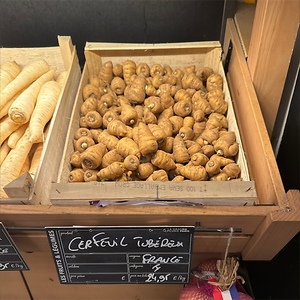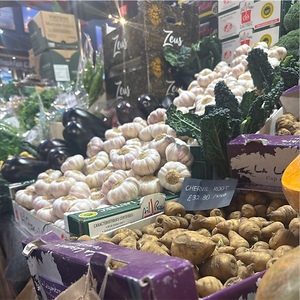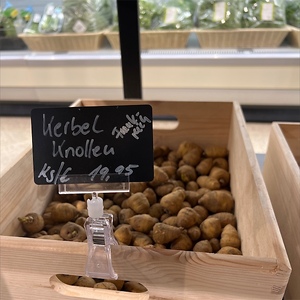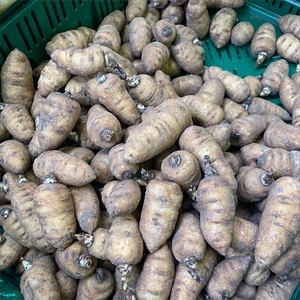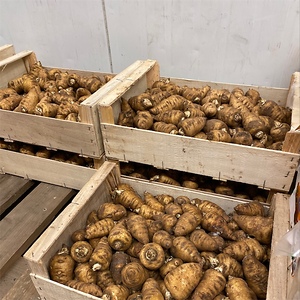

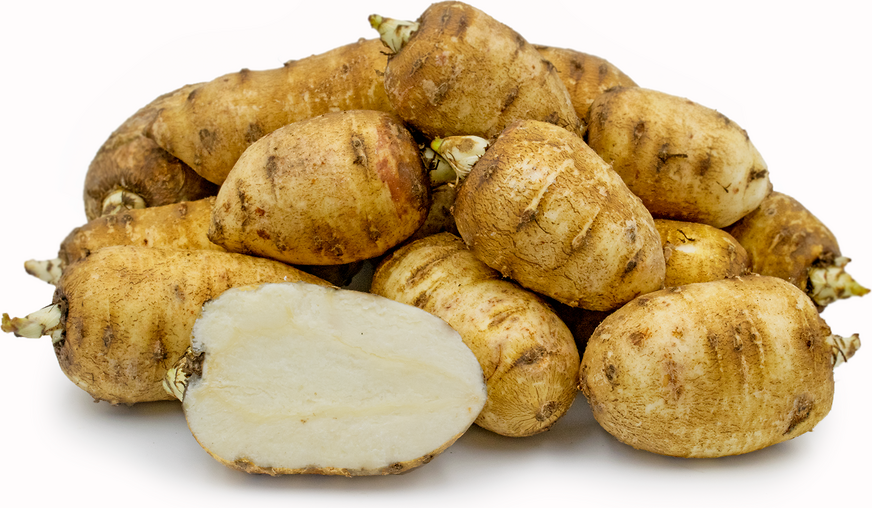
Chervil Root
Estimated Inventory, lb : 0
Description/Taste
Chervil root is small in size, averaging 5-7 centimeters in length, and is bulbous, short, and stubby in shape with rounded ends. The brown to tan skin is rough, covered in shallow eyes, and thin. Underneath the surface, the flesh is dense, ivory to cream-colored, and starchy. When cooked, Chervil root develops a soft consistency, similar to the texture of a cooked potato, and has a sweet flavor reminiscent of chestnuts, carrots, and parsnips. The leaves of the plant are also edible and have a taste similar to parsley.
Seasons/Availability
Chervil root is available in the early fall through winter.
Current Facts
Chervil root, botanically classified as Chaerophyllum bulbosum, is an edible, underground taproot of a biennial plant that can grow up to two meters in height and is a member of the Apiaceae family along with parsnips, carrots, and celeriac. Also known as Turnip-rooted Chervil, the plant thrives in cool climates and is cultivated on a small scale in Europe for its roots, especially in France. Chervil root is somewhat challenging to grow and is utilized similarly to other root vegetables in culinary applications.
Nutritional Value
Chervil root is high in fiber and has the same starchy quality as a potato. It contains favorable amounts of vitamins B and C and mineral salts. The rich carbohydrate reserves of Chervil root increase after a period of cold storage, making it a highly desirable crop for diversity and use as a food source. Such high levels of sucrose and starch in one root vegetable are rare, and the root is being further researched to improve crop yields for use as a significant crop.
Applications
Chervil root can be consumed raw, grated into green salads or utilized as a crunchy garnish, but it is most popularly used in cooked applications such as boiling, pureeing, steaming, and roasting. Much of the flavor and aroma is from the skin of the tuber, so it is advised not to peel the Chervil root prior to preparing it. Roots should also be thoroughly washed before use to remove any soil or debris. Chervil root can be braised alongside meats or other vegetables, boiled and mashed, or pureed. Chervil root pairs well with meats such as poultry, beef, lamb, and fish and other root vegetables like carrots, parsnips, and celeriac. The roots will keep up to three months when stored in a cool, dry, and dark place.
Ethnic/Cultural Info
Around the turn of the 19th century, famed French botanist Maurice Vilmorin believed Chervil root to be a valuable, edible tuber and suggested it be classified with the potato. Though Vilmorin saw value in the distinctly flavored root, it was only favored for a short period in Europe and has significantly declined in the last couple of hundred years due to its difficult growing habits and extended period of development. Despite its decrease in popularity, research and cultivation of this almost forgotten tuber began in France’s Loire Valley in the mid-1980s and is still being continued today. Focusing on increasing yield, limiting seed dormancy, and decreasing fragility, research has produced several cultivars like “Altan,” “Véga,” and “M4.10.,” and these cultivars have found a niche market among home gardeners growing Chervil root.
Geography/History
The origins of Chervil root are mostly unknown, but the root was believed to be native to Central and Eastern Europe and was used by the early Greeks and Romans. The root began to be cultivated on a small scale in the 1700-1800s and was then spread to the United States. Today Chervil root can be found in limited availability at fresh markets and specialty grocers in Europe, especially in France, and in the United States.
Recipe Ideas
Recipes that include Chervil Root. One
| Stefan's Gourmet |
|
Chervil and Parsley Root Puree |
| Great British Chefs |
|
Roast Venison Loin with Snails, Roasted Chervil Root, and Field Mushroom Puree |



